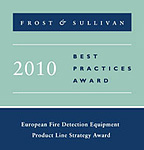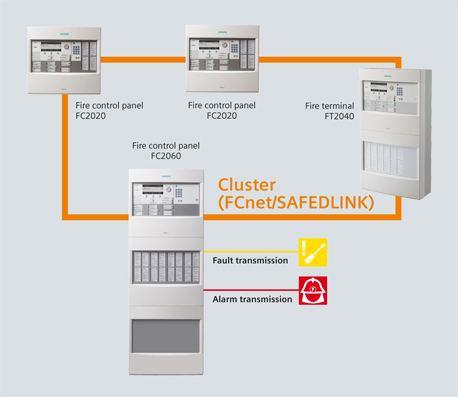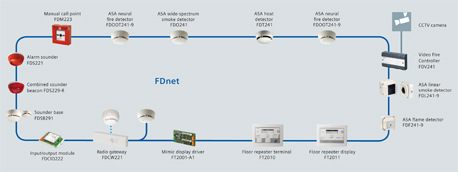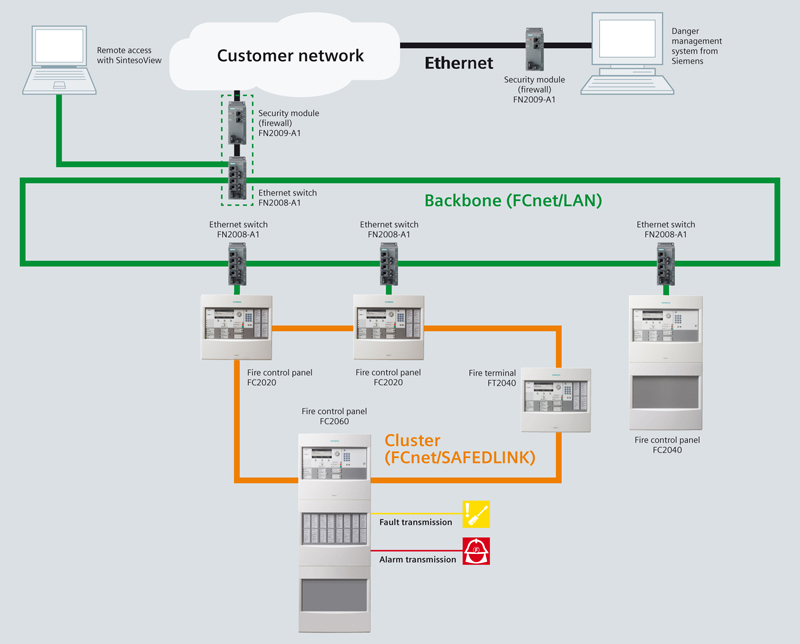Sinteso > Overview
Complete fire safety system
Protection against fire, heat, and smoke plays a key role in ensuring safety. That is why you need intelligent fire protection solutions to help you carry out your responsibility – solutions that detect dangers the second they occur, before they can get out of hand. Solutions that react correctly, quickly, and adequately, and help trigger the right response.
With Sinteso, we offer you:
- An integral system that protects your investments
- A system based on the latest technology platform for all functions, all building types and every form of future use

Award winning system
The Sinteso system has won the "2010 European Fire Detection Equipment Market Product Line Award". Frost & Sullivan’s market analysts have identified the Sinteso fire safety platform as best practice because of its unique proposition: Siemens provides to its customers a Genuine Alarm Guarantee, including financial compensation in the case of false alarms. "This promise provides Siemens with a matchless competitive edge in an overcrowded market where product differentiation is the most challenging aspect facing competitors", explained Hammam Ahmed, research analyst for Environment & Building Technologies at Frost & Sullivan.
Benefits at a glance
- Customized safety against all type of fires
- Reliability of the most experienced solution provider in the field of fire safety
- Open-ended solution for the future thanks to a far-sighted technology platform design
- All functions for fire, smoke, and heat detection
- All functions for fire, smoke, and heat detection
- Solutions and services for all applications whether simple or complex
- Easy to change and extend
- Communication with other safety systems
- Efficient modernization possibilities for existing fire detection systems
Sinteso system - new cluster/backbone architecture
The newest version of Sinteso even allows simple networking for very large applications as well. It is the first fire protection system in the world to have an EN 54-compliant fiber-optic backbone, which can be extended to include 64 fire control panels or terminals. Sinteso is thus able to protect companies, airports, hospitals, and universities whose buildings are spread out across a large area. With its outstanding Energy Monitoring and Controlling (EMC) performance, the fiber-optic backbone (FCnet/LAN) allows several clusters (FCnet/SAFEDLINK) of up to 16 fire control panels to be interconnected. In addition, this also enables the fire protection system to be expanded flexibly to include structures and buildings at a later time. As a general principle, the entire system is based on a redundant design: Each cluster is integrated within the backbone using two independent EN 54-compliant Ethernet switches. This cluster/backbone architecture with LAN technology ensures functional stability and high availability of the network at all times.
The concept offers a high degree of planning and operational flexibility because each control panel and terminal allows full access to the entire network. In addition, remote access is possible from existing networks by using special security modules and the SintesoView PC software. The entire network requires only one interface for both alarm and fault transmission as well as the pager and danger management system. This not only simplifies planning but also guarantees prompt alarm transmissions. Siemens thus offers the first IP network-based solution for fire protection that fully complies with EN 54 fire detection and fire alarm system standards on control, alarm transmission, visibility, and access.
Sinteso backbone (FCnet/LAN)
Clusters can be networked via an Ethernet backbone, using industrial LAN technology. Siemens is the first manufacturer who offers this as EN 54-approved solution. With standard IT architecture, building structures and organizational processes can be ideally represented.
Characteristics of networking via backbone
- Ethernet switch to connect a cluster (FCnet/SAFEDLINK) to the backbone (FCnet/LAN)
- Redundant transmission thanks to circular wiring
- Redundant connection possible due to two Ethernet switches
- Increased EMC protection thanks to fiber-optic cabling
- Easily programmable, EN 54-compliant system-wide control
- Configurable view of each panel
- Each panel can be used as a router panel (please read separate documentation).
Key data
- Max. number of panels in EN 54 system: 64
- Max. number of panels in a cluster: 16
- Max. number of networkable clusters: 14
- Number of panels placed directly on backbone: 4*
- Number of panels with system-wide view: 5*
- Max. distance between clusters (fiber optic: multi mode): 3,000 m
The following guidelines must be considered
- To fulfill the EN 54 norm, only 1 Ethernet switch is required to connect control panels with less than 512 fire detectors to the backbone
Sinteso cluster (FCnet/SAFEDLINK)
FCnet/SAFEDLINK stations for different requirements
The FCnet is the network for connecting up to 32 Sinteso fire control panels and terminals.They can be networked in any configuration via the powerful FCnet. The innovative, redundant network node sets new standards not only in terms of fault tolerance, but also interms of fast data transmission.

Characteristics of networking via the system bus
- Wiring with two-wire lines
- Redundant transmission thanks to circular wiring
- Increased safety due to degrade mode using a second network module
- No additional cabling necessary for degrade mode; even for systems with more than 512 fire detectors
- Configurable view of individual panels
Key data
- Max. number of panels in a cluster: 32
- Max. number of panels in a cluster if connected to a danger management system: 16
- Max. distance between panels with copper cable
- without repeater: 1,000 m
- with repeater: 2,000 m - Max. distance between panels with fiber-optic cable
- multi mode: 2,500 m
- single mode: 15,000 m - Max. number of panels with system-wide view: 5
Sinteso field device network FDnet
FDnet: The network that supplies everything
The FDnet (Field Device network) is a modern, multipurpose bus system. It allows rapid, fail-safe communication between the Sinteso™ bus elements and the fire control panel.

Characteristics of networking via the detector bus
- Use of all cable types (shielded or unshielded)
- Integration of star-shaped cable networks without modifications to cable network
- Shielding not necessary
- 2-wire loop
- Power supply to all bus elements via the FDnet (except “transponder” FDCIO223, LaserFOCUS, extinguishing control unit XC10, video fire controller FDV241)
Key data
- Up to 40 T-taps
- Up to 126 bus elements on one loop
- Cable lengths up to 3.3 km with up to 126 bus elements


